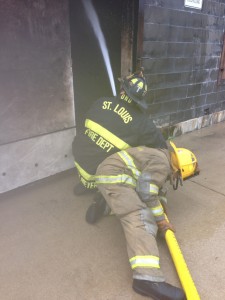In my years as a younger firefighter, both as a volunteer and during my career training, it was driven home that we enter building fires with a low profile. More specifically on our hands and knees. I was never going to question my instructors, the books or the more veteran firefighters that mentored me. However, the more fires I got to fight, the more I started to question some of that advice.
During my career I have taken many classes, both locally and nationally at conferences like FDIC, and my local academy. What I started to learn from these classes is that to stay up or down is not an always or never debate. Some of my own thoughts and impressions were validated by firefighters and officers with more experience than me.
Since then, by using what was taught to me and from my own experiences, I have learned that there is a time and place for both methods. I recently listened to a young firefighter explain to me that he was taught to always enter a fire building on his hands and knees. He couldn’t understand why I was suggesting something different.
We get the privilege and honor to teach firefighters every year throughout our state on engine company operations. When we do, we certainly advise staying low. However, there is something to be said for using some common sense, some training and education and some experience to get to the fire a little quicker. In some cases, it’s not wrong or taboo to be on our feet to move the line a little quicker and to get to victims and the fire a little quicker.
However, you must take into consideration the entire event (the big picture) if you are going to be a little upright. Here are a few things to consider before you drop to our knees or stand upright.
- a 360 must be done in any event to see the whole picture and locate the fire before committing (of course there are exceptions due to size and location and obstructions, do the best you can!)
- your resources matter; having a smaller crew size may lend itself better to being crouched if conditions allow to move faster.
- you want an officer with a TIC watching conditions overhead for both methods, it is critical we keep an eye on heat signatures and changing conditions over our head
- if you have to cool as you move you should be down
- if you’re up, you should not be blind; if it gets that bad get down
- if you’re up, you should not be melting your shield, too hot means to get down and cool as you move
- if you’re searching, you should be down, you need to be where the victims are
- if you’re going to go in up, you still need to be aware of the integrity of the floor, don’t run in without reckless abandon
- if you’re up, be extra careful for open stairwells; again, don’t be blind
There are some I’m sure others have used that are not on this list, but it worked for me. The point is to be smart and efficient. We can make entry upright, we don’t have be on our hands and knees at every fire. Is there a calculated risk? Yes, that’s why you need to train and have some guidelines and boundaries.
However, there are some risks in going in on your hands and knees too. The worst that we see is literally firefighters on their hands and knees. We cannot effectively and efficiently advance a hose line or search a space when we are on all fours as compared to being on a back leg, crouching or other techniques that keeps our head up.
When we are on all fours our head is naturally down. That means your eyes are down and you aren’t seeing conditions. It is also significant slower than other methods. I’ve had firefighters tell me it’s the only way to avoid the heat. I say to them they should flowing as they go then. Heads down don’t allow for you to see conditions, fire and fellow firefighters.
Whatever method you use, be able to move fast, be efficient, and have your head up. Especially moving the line; it is much easier when you’re not on all fours. Being on a back leg or in a crouch allows you to use your legs and lower body to help move the line.
If you have some additional tips, share with the readers. Next week I’ll discuss tools for the engine company: to take a tool or not to as the first due engine. Until then, be well and take care.
